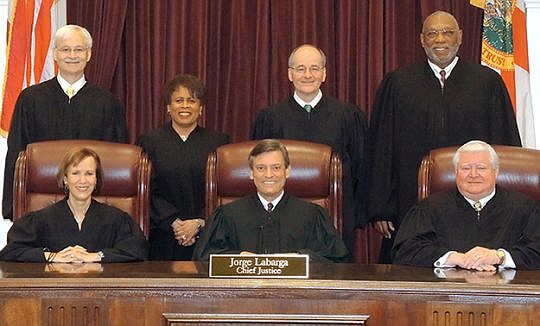
More than a dozen years after a fierce political fight about the state’s medical-malpractice laws, the Florida Supreme Court last week heard arguments about the constitutionality of limits on damages in malpractice lawsuits.
The Broward County case stems from injuries suffered in 2007 by dental assistant Susan Kalitan, who went into surgery for carpal-tunnel syndrome and ended up with a perforated esophagus because of tubes inserted into her mouth and esophagus during anesthesia.
The Supreme Court’s ultimate ruling likely will address the most-controversial issue in the Legislature’s 2003 overhaul of the medical-malpractice system: whether non-economic damages, commonly known as pain and suffering damages, should be capped.
Justices, who typically take months to rule in such cases, gave little indication Thursday about how they might rule.
But the court in 2014 found that damage caps were unconstitutional in a wrongful-death malpractice case involving a woman who died after giving birth in a Panhandle hospital.
Details of the cases differ, including that Kalitan’s lawsuit is a personal-injury case instead of a wrongful-death case.
Kalitan filed a lawsuit in 2008 against the North Broward Hospital District and other defendants, and an appeals court ruled last year that the limits on non-economic damages were unconstitutional. The case then went to the Supreme Court.
Lawmakers and then-Gov. Jeb Bush spent months debating caps and other changes in the malpractice system in 2003 amid what doctors described as a “crisis” of high insurance premiums. Plaintiffs’ attorneys vehemently opposed the damage limits, which they said would hurt injured patients.
Bush eventually signed a law that capped damages at different amounts, depending on factors such as the numbers of claimants in lawsuits and the types of defendants in the case.
In the Kalitan trial, for example, a jury awarded $4 million in non-economic damages, but the amount was reduced by about $2 million because of the caps in the 2003 law.
During arguments last week in the Kalitan case, Justice Barbara Pariente questioned whether the Legislature’s justification for the limits still stands.
“Is there a rational basis for this cap on damages in the year 2016, based on a crisis that was said to exist 20 or 30 years ago?” she asked.
But Dinah Stein, an attorney for the hospital district and other defendants, suggested that the Kalitan case does not show whether a malpractice insurance crisis exists.
“If we are going to find that the crisis is over, or there was never a crisis, or so forth … it needs to be done with evidence in an (adversarial) proceeding, to determine whether and when this is the case,” she said.
Philip Burlington, an attorney for Kalitan, asked the court to follow findings from the 2014 ruling in the malpractice case resulting from the death of Michelle McCall.
“The injury to Michelle McCall when she died was in 2006, the injury to my client was in 2007. … If (an insurance crisis) didn’t exist in 2006, it didn’t exist in 2007 when my client suffered her injuries,” Burlington said.